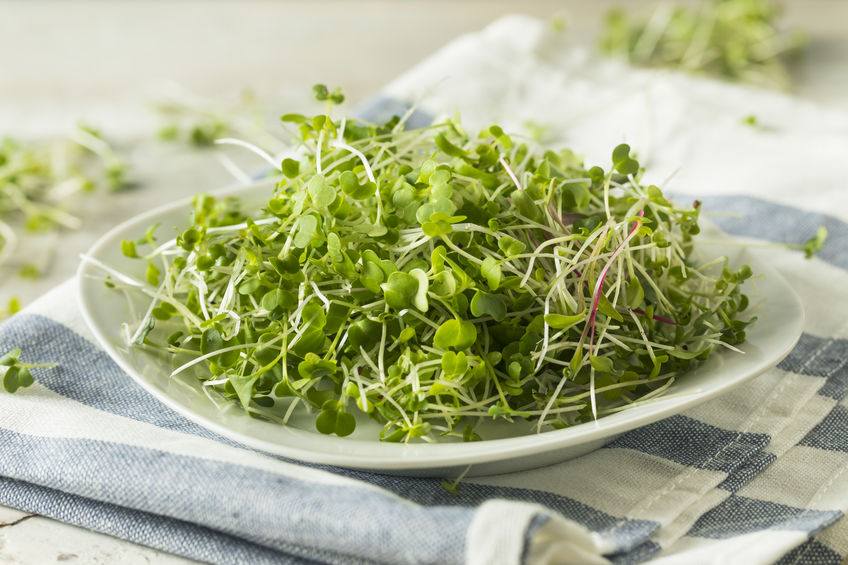By John Salak –
Move the Brussels sprouts aside, microgreens are likely coming to your table soon and in abundance. These leafy niblets that some describe as vegetable confetti, in fact, may be the perfect eating-green alternative to traditional produce, according to a recent study from Colorado State University.
Microgreens aren’t entirely new. People have been using them as garnishes for eons and more recently a number of chefs have been serving them up in their restaurants because of their looks and taste. What’s now becoming increasingly apparent is that microgreens are gaining widespread appeal because they come in lots of options; can be sustainably farmed; are easy to grow, even in urban areas through vertical farming; and pack a nutritional punch.
As a quick primer, microgreens come from lots of forms. They are the young and tender leafy greens that many vegetables, grains, herbs and flowers yield, which are harvested when their leaves first appear. They grow in weeks, need little water and thrive in rapid controlled-environment agriculture, which translate to indoor farming. Ultimately, they can be produced year-round in almost any setting, such as greenhouses, warehouses, vertical farms and even homes.
“You’ve probably heard of sprouts and baby greens. These are somewhere in the middle,” explained Sarah Ardanuy Johnson, the lead researcher and an assistant professor and director of the Functional Foods & Human Health Laboratory at Colorado State.
These greens offer a hard-to-ignore environmental and nutritional payback, she added. “The need for our food to be more sustainable is greater than ever. I love the idea that they can be grown in an urban environment, indoors in big cities and smaller towns. We can’t just grow everything in the soil outside anymore, and we need to conserve what natural resources we still have,” Johnson said.
Of course, nutrition and sustainability will only carry microgreens so far if consumers won’t buy in, which led Johnson and a team of researchers to survey 99 people on their reactions to six different types of microgreens: arugula, broccoli, bull’s blood beet, red cabbage, red garnet amaranth and tendril pea. The respondents answered various questions on the flavor, aroma, texture and appearance of these microgreens. The overall results bode well for microgreens as they rated highly for appearance, flavor and texture, while scoring lower on factors like astringency, bitterness, heat and sourness.
“But they were all liked well enough that people said they would consume them and purchase them,” Johnson noted. “I feel like they should be used more as a vegetable and not just a garnish.”
The growing popularity of microgreens is underscored by a recent report by Research And Markets, a British consumer sector research group. It projects the global market for this vegetable confetti will grow by 7.5% annually through 2025 with broccoli, lettuce, arugula and basil microgreens leading the way.
The benefits of taste and sustainable farming aside, microgreens are akin to the Mighty Mouse of vegetables. Earlier research out of the University of Maryland, in fact, reported that these tiny greens pack up to 40 times more vital nutrients than their fully-grown counterparts.
The biggest nutrient returns came from red cabbage, cilantro and radishes, the study noted. But even alternative microgreens offered up some substantial benefits, which included high levels vitamins K, C and E, lutein and beta-carotene.
“The microgreens were four- to 40-fold more concentrated with nutrients than their mature counterparts,” Qin Wang, PhD, a researcher and assistant professor at the university, reported when the study was released. “When we first got the results, we had to rush to double and triple check them.”
Okay, so microgreens are good for you and easy to commercially farm. Some people also think they’re cute, hence the vegetable confetti reference. Want one more incentive to embrace microgreens? Apparently, they can be grown right in your home whether that home is an apartment or a house.
“Second only to sprouts, microgreens are the quickest food crop we urban gardeners can grow. If you have limited time, space or gardening skills let me introduce you to growing microgreens. You can learn how to grow microgreens – tasty, nutrient-dense ‘fast food’ – in just a few easy steps,” according to The Micro Gardener, which outlines the process.
All this begs the question. Why not toss in some vegetable confetti around your house—or at least around the kitchen or dining room?













